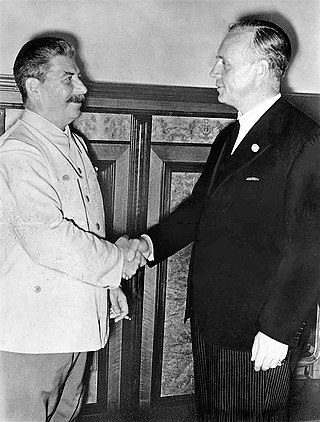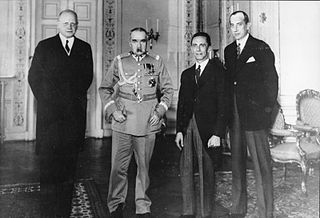
The Molotov–Ribbentrop Pact, officially the Treaty of Non-Aggression between Germany and the Union of Soviet Socialist Republics, was a non-aggression pact between Nazi Germany and the Soviet Union with a secret protocol that partitioned Central and Eastern Europe between them. The pact was signed in Moscow on 23 August 1939 by German Foreign Minister Joachim von Ribbentrop and Soviet Foreign Minister Vyacheslav Molotov. Unofficially, it has also been referred to as the Hitler–Stalin Pact and the Nazi–Soviet Pact.

The Axis powers, originally called the Rome–Berlin Axis and also Rome–Berlin–Tokyo Axis, was a military coalition that initiated World War II and fought against the Allies. Its principal members were Nazi Germany, the Kingdom of Italy and the Empire of Japan. The Axis were united in their far-right positions and general opposition to the Allies, but otherwise lacked comparable coordination and ideological cohesion.

The Sykes–Picot Agreement was a 1916 secret treaty between the United Kingdom and France, with assent from the Russian Empire and the Kingdom of Italy, to define their mutually agreed spheres of influence and control in an eventual partition of the Ottoman Empire.

The Anti-Comintern Pact, officially the Agreement against the Communist International was an anti-Communist pact concluded between Nazi Germany and the Empire of Japan on 25 November 1936 and was directed against the Communist International (Comintern). It was signed by German ambassador-at-large Joachim von Ribbentrop and Japanese ambassador to Germany Kintomo Mushanokōji. Italy joined in 1937, but it was legally recognized as an original signatory by the terms of its entry. Spain and Hungary joined in 1939. Other countries joined during World War II.
The events preceding World War II in Europe are closely tied to the bellicosity of Fascist Italy, Nazi Germany, Francoist Spain, and Imperial Japan, as well as the Great Depression. The peace movement led to appeasement and disarmament.

The causes of World War II have been given considerable attention by historians. The immediate precipitating event was the invasion of Poland by Nazi Germany on September 1, 1939, and the subsequent declarations of war on Germany made by Britain and France, but many other prior events have been suggested as ultimate causes. Primary themes in historical analysis of the war's origins include the political takeover of Germany in 1933 by Adolf Hitler and the Nazi Party; Japanese militarism against China, which led to the Japanese invasion of Manchuria and the Second Sino-Japanese War; Italian aggression against Ethiopia, which led to the Second Italo-Ethiopian War; or military uprising in Spain, which led to the Spanish Civil War.
The Hoare–Laval Pact was an initially secret pact made in December of 1935 between French Foreign Minister Pierre Laval and British Foreign Secretary Sir Samuel Hoare for ending the Second Italo-Ethiopian War. Italy wanted to incorporate the independent nation of Abyssinia (Ethiopia) into its Italian Empire and also avenge the 1896 Battle of Adwa, a humiliating defeat. The pact proposed to partition Abyssinia and thus partially achieve Italian dictator Benito Mussolini's goal of making Abyssinia an Italian colony.

After the Russian Revolution, in which the Bolsheviks took over parts of the collapsing Russian Empire in 1918, they faced enormous odds against the German Empire and eventually negotiated terms to pull out of World War I. They then went to war against the White movement, pro-independence movements, rebellious peasants, former supporters, anarchists and foreign interventionists in the bitter civil war. They set up the Soviet Union in 1922 with Vladimir Lenin in charge. At first, it was treated as an unrecognized pariah state because of its repudiating of tsarist debts and threats to destroy capitalism at home and around the world. By 1922, Moscow had repudiated the goal of world revolution, and sought diplomatic recognition and friendly trade relations with the capitalist world, starting with Britain and Germany. Finally, in 1933, the United States gave recognition. Trade and technical help from Germany and the United States arrived in the late 1920s. After Lenin died in 1924, Joseph Stalin, became leader. He transformed the country in the 1930s into an industrial and military power. It strongly opposed Nazi Germany until August 1939, when it suddenly came to friendly terms with Berlin in the Molotov–Ribbentrop Pact. Moscow and Berlin by agreement invaded and partitioned Poland and the Baltic States. Stalin ignored repeated warnings that Hitler planned to invade. He was caught by surprise in June 1941 when Nazi Germany invaded the Soviet Union. The Soviet forces nearly collapsed as the Germans reached the outskirts of Leningrad and Moscow. However, the Soviet Union proved strong enough to defeat Nazi Germany, with help from its key World War II allies, Britain and the United States. The Soviet army occupied most of Eastern Europe and increasingly controlled the governments.

This timeline of events preceding World War II covers the events that affected or led to World War II.
The Franco-Polish Alliance was the military alliance between Poland and France that was active between the early 1920s and the outbreak of the Second World War. The initial agreements were signed in February 1921 and formally took effect in 1923. During the interwar period the alliance with Poland was one of the cornerstones of French foreign policy.
A separate peace is a nation's agreement to cease military hostilities with another even though the former country had previously entered into a military alliance with other states that remain at war with the latter country. For example, at the start of the First World War, Russia was a member, like the United Kingdom and France, of the Triple Entente, which went to war with the Central Powers formed by Germany and Austria-Hungary, later joined by the Ottoman Empire and Bulgaria. After the abdication of Nicholas II during the February Revolution and the subsequent Russian Provisional Government's overthrow by the Bolsheviks during the October Revolution, Russia defaulted on its commitments to the Triple Entente by signing a separate peace with Germany and its allies in 1917. This armistice was followed on March 3, 1918, by the formal signing of the Treaty of Brest-Litovsk.

The German–Polish declaration of non-aggression, also known as the German–Polish non-aggression pact, was an agreement between Nazi Germany and the Second Polish Republic that was signed on 26 January 1934 in Berlin. Both countries pledged to resolve their problems by bilateral negotiations and to forgo armed conflict for a period of 10 years. The agreement effectively normalised relations between Poland and Germany, which had been strained by border disputes arising from the territorial settlement in the Treaty of Versailles. The declaration marked an end to an economically damaging customs war between the two countries that had taken place over the previous decade.
The military alliance between the United Kingdom and Poland was formalised by the Anglo-Polish Agreement in 1939, with subsequent addenda of 1940 and 1944, for mutual assistance in case of a military invasion from Nazi Germany, as specified in a secret protocol.
The Polish–Romanian alliance was a series of treaties signed in the interwar period by the Second Polish Republic and the Kingdom of Romania. The first of them was signed in 1921 and, together, the treaties formed a basis for good foreign relations between the two countries that lasted until World War II began in 1939.

The bilateral relations between the Italian Republic and the United Kingdom of Great Britain and Northern Ireland are warm and exceptionally strong. Both nations are members of the United Nations, NATO, Council of Europe, Organisation for Economic Co-operation and Development, Organization for Security and Cooperation in Europe, G7 and G20 major economies, World Trade Organization, and among others.
The Franco-Soviet Treaty of Mutual Assistance was a bilateral treaty between France and the Soviet Union with the aim of enveloping Nazi Germany in 1935 to reduce the threat from Central Europe. It was pursued by Maxim Litvinov, the Soviet foreign minister, and Louis Barthou, the French foreign minister, who was assassinated in October 1934, before negotiations had been finished.
The Franco-Belgian Military Accord of 1920 was a collective defense pact signed between France and Belgium in September 1920. The Accord was cancelled in 1936 as Belgium returned to pursuing a policy of neutrality, which it would continue until the Second World War.
International relations (1919–1939) covers the main interactions shaping world history in this era, known as the interwar period, with emphasis on diplomacy and economic relations. The coverage here follows the diplomatic history of World War I and precedes the diplomatic history of World War II. The important stages of interwar diplomacy and international relations included resolutions of wartime issues, such as reparations owed by Germany and boundaries; American involvement in European finances and disarmament projects; the expectations and failures of the League of Nations; the relationships of the new countries to the old; the distrustful relations between the Soviet Union and the capitalist world; peace and disarmament efforts; responses to the Great Depression starting in 1929; the collapse of world trade; the collapse of democratic regimes one by one; the growth of economic autarky; Japanese aggressiveness toward China; fascist diplomacy, including the aggressive moves by Fascist Italy and Nazi Germany; the Spanish Civil War; the appeasement of Germany's expansionist moves toward the Rhineland, Austria, and Czechoslovakia, and the last, desperate stages of rearmament as another world war increasingly loomed.
The Bérard-Jordana Agreement, also called Berard-Jordan Agreement in English, was a political treaty signed by France and Spain in Burgos on 25 February 1939. Its name is based on the two principal signatories, Léon Bérard for France and General Francisco Gómez-Jordana Sousa for Spain.

On 23 October 1936, a nine-point protocol was signed by Fascist Italy and Nazi Germany in Berlin. It was the first concrete expression of the Italo-German rapprochement that began earlier that year. It was signed by the foreign ministers Galeazzo Ciano and Konstantin von Neurath. On the same day in Berlin, the Anti-Comintern Pact between Germany and Japan was initialed by Ambassador-at-Large Joachim von Ribbentrop and Ambassador Kintomo Mushanokoji.









